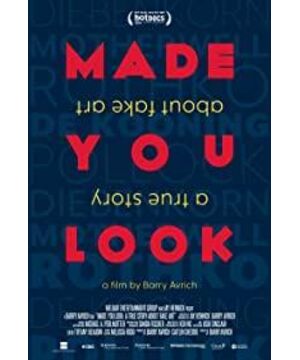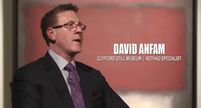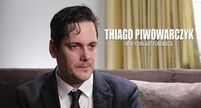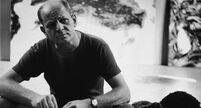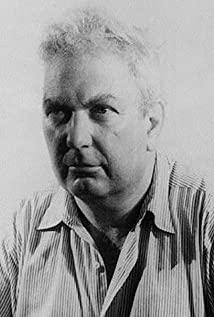I don't have an art background, I'm not familiar with the auction market, and occasionally I like to visit art galleries, small galleries, and buy cheap souvenirs. If there's any reason why I clicked into such a documentary among so many great Netflix movies, it's that I love Mark Rothko. This is one of the few American abstract artists whose names I can spell. After watching the movie, however, there was a fragment that lingered in my mind. When the fake was displayed in the courtroom, Rothko's son watched it for a long time and said, "It is beautiful."
I actually felt a lost tenderness and such an out of place humor from this clip.
This documentary is actually full of humor. If I say, there is a magnetic field of humor in itself between abstract art and the general public. The Contemporary Art Museum in Los Angeles is right downstairs from my company, and I often go in for a walk to refresh myself. The millions of works of art act like giant hawthorn slices hanging on the wall. Desecrate art? And many people use them as backgrounds for selfies. But I sincerely feel joy when I walk in it. Maybe I can't comprehend life in the colorful black, but it doesn't prevent me from thinking that there are some paintings, a few statues, lines at a certain angle, special color matching, beautiful.
The value of art has been fragmented. Collectible value, auction value, market value; and purely aesthetic value. I can't help but wonder if our aesthetics have been domesticated by the first value. And the presentation of the people who dominate the first value in this documentary, in my personal opinion, is very, interesting/funny. "She hurt my feelings and trust!" The rich people's feelings are also dared to be sullied by ordinary people! There are many interesting little clips in the film. It is difficult for my clumsy brushwork to vividly describe them. Go and see!
But thanks to Tom Ford chairman Domenico De Sole and his wife Eleanore (who feels rich housewives are already synonymous with drama) taking Knoedler Gallery and Ann Freedman to court, we can get a glimpse into the tacit secrets of the opulent art collecting world . The famous art museum collections all over the world receive tens of thousands of tourists every day. And how much of the artwork hanging on the wall is actually by the artist on the label? Noah Charney's "The Art of Forgery" says that there is no shortage of fakes in works exhibited or collected by museums such as Getty in Los Angeles, and the museums themselves are well aware of this. This is paradoxical. Perhaps with the endorsement of these big museums, the fakes have accumulated enough essence of heaven and earth, and after many years, the golden elixir will be cast and become immortal. It is not uncommon to be a master imitator who is known as a fake and even sells his works for a high price to become a recognized artist. It is said that one who may know more is Zhang Daqian (but people still rely on their own creations to rectify the name).
Who is this $840,000 worth of American abstraction master spiritual core? Mr. Qian, a Chinese painter in his 70s, was Ai Weiwei's classmate during his studies in the United States. These paintings are both a stain on his life (forging signatures and getting paid for is a gray area) and a great achievement. The works hidden in the garage and secretly tinkering with are identified by the world's top experts one by one and said to be genuine. The rich and powerful are vying to have them. The world's major museums are on tour and thousands of people salute in front of your paintings. Worship, if it were me, I would go out laughing and go out, everyone in the world was drunk and I woke up alone.
Forgot to see which art gallery the introduction said that Mark's paintings are not simple color blocks, each color has many layers. With the difference and accumulation of brushstrokes, directions, painting time and other factors, those seemingly same colors slowly turned into different shades, creating hidden lines (cough, I am a painter with strong painting skills). So when you stand in front of a painting long enough, you slowly see some shapes in it, and at the edges of the color blocks and color blocks, it seems that there is light spilling out. This is how I really felt, and I promise I didn't have hallucinations due to lack of oxygen in my brain. I have also seen some other well-known (possibly) contemporary artist's scribbling works (that is, the entire canvas is a hand-painted line, a common skill for art students and architecture students). The painter realized it in the process of continuously extending the lines. . . . . Well, I forgot what he realized. Anyway, I realized one thing, art is what you say it is, because you can always crown it with a future we can't know. Isn't that right, the works that have settled in the art temple belong to the past. The longer it has in the past, the more modern people are willing to have it at a higher price. What is the value of art, and what do we ask for in art? The right to talk to time? Is it possible to empathize with the historical era? Are you looking for yourself in someone else's soul?
Of course, this is not a topic discussed in this documentary, nor is it a topic that the art collecting community cares about. For a normal person like me, it is just beautiful.
Before going to bed, I remembered a favorite scene. When Ann, the central character of this tornado, was asked by the gallery owner to resign on the excuse of her recurrence of lung cancer, she felt betrayed, helpless and humiliated, and finally said goodbye subconsciously. Say thank you.
"the manner just kicked in" (probably so, the translation may be, the fault of the gentleman)
Whether Ann is black or white, only her own conscience knows. But in the end, she is still a gentleman.
In addition, I recommend an article I found when I wrote my review:
From Fake to Replica: Vanishing Artistic Authenticity by Playby
View more about Made You Look: A True Story About Fake Art reviews


